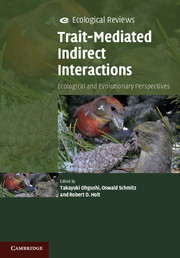Book contents
- Frontmatter
- Contents
- Contributors
- Foreword
- Preface
- Chapter One Introduction
- Part I Community
- Chapter Two Perspective
- Chapter Three Consequences of trait changes in host–parasitoid interactions in insect communities
- Chapter Four The impact of trait-mediated indirect interactions in marine communities
- Chapter Five Trait-mediated indirect interactions in size-structured populations
- Chapter Six Trait-mediated effects, density dependence and the dynamic stability of ecological systems
- Chapter Seven Plant effects on herbivore–enemy interactions in natural systems
- Chapter Eight The implications of adaptive prey behaviour for ecological communities
- Chapter Nine Community consequences of phenotypic plasticity of terrestrial plants
- Chapter Ten Model-based, response-surface approaches to quantifying indirect interactions
- Part II Coevolution
- Part III Ecosystem
- Part IV Applied Ecology
- Index
- Plate Section
- References
Chapter Six - Trait-mediated effects, density dependence and the dynamic stability of ecological systems
Published online by Cambridge University Press: 05 February 2013
- Frontmatter
- Contents
- Contributors
- Foreword
- Preface
- Chapter One Introduction
- Part I Community
- Chapter Two Perspective
- Chapter Three Consequences of trait changes in host–parasitoid interactions in insect communities
- Chapter Four The impact of trait-mediated indirect interactions in marine communities
- Chapter Five Trait-mediated indirect interactions in size-structured populations
- Chapter Six Trait-mediated effects, density dependence and the dynamic stability of ecological systems
- Chapter Seven Plant effects on herbivore–enemy interactions in natural systems
- Chapter Eight The implications of adaptive prey behaviour for ecological communities
- Chapter Nine Community consequences of phenotypic plasticity of terrestrial plants
- Chapter Ten Model-based, response-surface approaches to quantifying indirect interactions
- Part II Coevolution
- Part III Ecosystem
- Part IV Applied Ecology
- Index
- Plate Section
- References
Summary
Introduction
One of the most basic things that can be said about the ecology of a species is that the traits of its members (in a given environmental setting) influence that species’ demographic rates – births, deaths and movements – as well as transitions such as changes in body size or condition. When species interact, their demographic rates interlock, so changes in the abundance or traits of one species affect the vital rates of the others (and vice versa, sometimes). A message elaborated throughout this volume is that due to the fundamental connection between traits and demography, the traits of interacting individuals, and in particular plasticity in those traits, can have ramifying influences for many different issues in ecology and evolutionary biology, including in particular the percolation of indirect interactions through complex communities (e.g., Krivan and Schmitz 2004; Ohgushi 2005; Abrams 2010; Utsumi et al. 2010).
A perennial issue in population ecology is understanding how density dependence influences the abundance and distribution of species. Here we argue that an explicit concern with density dependence is – or should be – of central interest as well in articulating the ecological impact of trait-mediated indirect effects (TMIEs). We start with general comments on how the traits involved in indirect interactions can also influence density dependence. We provide a brief overview of prior literature that touches on density dependence in the context of trait-mediated interactions and present a simple theoretical model to illustrate how trait-mediated effects can influence density dependence. The term ‘stability’ in ecology encompasses several distinct concepts, such as the return of a population or community to a reference state following disturbance, or the persistence of ecological systems over time (Grimm and Wissel 1997). Understanding the causes of stability for essentially all these meanings requires one to gauge how density dependence operates over both short and long timescales, via both direct and indirect mechanisms.
Information
- Type
- Chapter
- Information
- Trait-Mediated Indirect InteractionsEcological and Evolutionary Perspectives, pp. 89 - 106Publisher: Cambridge University PressPrint publication year: 2012
References
Accessibility standard: Unknown
Why this information is here
This section outlines the accessibility features of this content - including support for screen readers, full keyboard navigation and high-contrast display options. This may not be relevant for you.Accessibility Information
- 9
- Cited by
